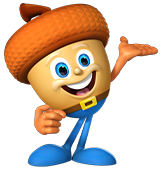Mathseeds Levels Overview
Reception Maths
Lessons 1–50
The first 20 lessons are for children with little or no mathematical skills. Children learn fundamental number skills including number recognition, number words and counting. The Mathseeds characters led by Mango introduce a range of skills including recognising the shape of each number 0–10 and one-to-one correspondence. Children are also introduced to the four basic 2D shapes: circle, square, triangle and rectangle, colours and some simple concepts of size: big, small, short, tall etc.
Lessons 21–50 develop growing mathematical skills. Children learn to count forwards and backwards to twenty with confidence. They use a range of techniques including ten frames and number lines. They also learn the number words up to twenty. Addition is introduced and children add up to ten and doubles to five. Mango and the other Mathseeds characters present the concepts of passing time, life cycles and days of the week during these lessons. Children develop their understanding of 2D shapes by sorting them according to their properties. They are also introduced to four 3D shapes: sphere, cube, cone and cylinder.
Reception Maths Lessons OverviewYear 1 Maths
Lessons 51–100
Mathseeds Lessons 51–100 build on the skills children have acquired earlier in the programme. Children learn to count to 100, order numbers and identify ordinal numbers to 10th. An understanding of place value is developed, including trading ones for tens. Children identify money – notes and coins, and investigate fractions, focusing on wholes, halves and quarters. Subtraction is introduced, and children initially add and subtract to 10, and then to within 100. Strategies include counting on, counting back, near doubles and using number fact families. Children learn how to skip count by 2s, 5s and 10s, as well as early multiplication and division skills of grouping and sharing. The concepts of area and volume are introduced in these lessons, and children continue to investigate the features of 2D shapes and 3D objects. Children follow simple directions to a particular location and learn to read digital and analogue clocks to the half-hour. Tally charts and simple picture graphs are introduced. Children also work with the concept of chance and the likelihood of things happening.
Year 1 Maths Lessons OverviewYear 2 Maths
Lessons 101–150
Mathseeds lessons 101–150 introduce a range of new concepts and consolidate skills taught previously. Children learn to count to 1000, identify odd and even numbers and round to the nearest 10 and 100. They continue to develop place value skills; composing and decomposing numbers to 999. Addition and subtraction strategies are further developed, including the ‘jump’ and ‘split’ methods, as well as vertical addition and subtraction. Children continue to practise grouping and sharing and use of the multiplication and division signs. They are also taught how to find fractions of a collection of items. Children investigate length and are shown how to measure in metres and centimetres. They investigate the way 2D shapes move and reflect, as well as how 3D objects are constructed. Children tell the time to the quarter-hour and the nearest 5 minutes, and use a calendar to identify particular dates. They construct tally charts and simple picture graphs, and interpret data in a variety of ways.
Year 2 Maths Lessons OverviewYear 3 Maths
Lessons 151–200
Mathseeds lessons 151–200 cover a range of numeracy topics taught in grade 3. Children learn numbers to 10 000, counting forward and backward in thousands, hundreds and tens, and ordering bigger numbers from smallest to largest. They will explore angles, vertical and horizontal lines of symmetry, and identify images in the environment that are symmetrical. Children will also be introduced to the L and ml units of measure, and learn to read increments on measuring jugs to determine the amount of liquid. They will also learn to count squares to measure area, and multiply length by width to find the area in square units. Multiplication and division strategies are explored, including times tables and related division facts. Children will explore currency in more depth, as well as fractions, furthering their understanding of the role of top and bottom numbers in a fraction using the term ‘denominator’.
Year 3 Maths Lessons OverviewYear 4 Maths

Mathseeds Prime, Lessons 1–59
The first 15 units of Mathseeds Prime include 59 lessons targeted to children in Year 4. The units explore number and fractions, operations and geometry. Children will learn about numbers to 100,000, counting fractions and equivalent fractions. They will be introduced to decimals and develop their understanding of place value and decimal fractions. They will also extend their skills in addition and subtraction strategies and algorithms, multiplication thinking and strategies, as well as division strategies. They will explore patterns in multiplication and work on word problems involving all four operations and money. Children will explore 2D shape movements, 3D objects and angles, as well as learn to read maps. Measurement units will be available soon.
Please note: Year 4 Lessons are located in Mathseeds Prime, a separate program that’s available free with any Mathseeds subscription.
Year 4 Maths Lessons Overview (Mathseeds Prime)


